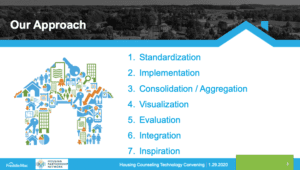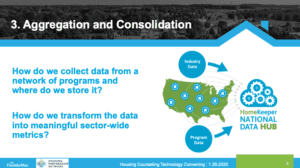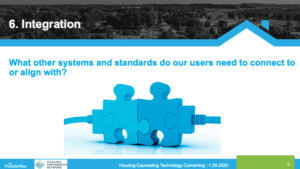
On January 29th, 2020 Tiffany Eng, our HomeKeeper Program Director, presented at the Foundations for Comprehensive Partnerships – Harnessing Technology and Data Standardization for Housing Counseling. The one-day event was co-hosted by the Housing Partnership Network and Freddie Mac in McLean, Virginia. The focus of the day was on the potential for sector-wide collaboration around the standardization of housing counseling data. As part of a panel on CMS Perspectives on Data Standards, Tiffany shared an overview of HomeKeeper’s ten year journey to standardize and leverage data within the shared-equity homeownership sector. The following is a transcript of her remarks.

Hi everyone, and thank you to Freddie Mac and Housing Partnership Network for hosting. I’m grateful to be able to spend this day with you and to be up here sharing my perspective.
For some background, HomeKeeper is a Salesforce app and CMS we’ve been working on since 2010. We started with 3 Community Land Trusts, all housing counseling agencies. Together we built HomeKeeper so program staff could manage their programs and property portfolios, and follow homebuyers from initial intake, through post-purchase stewardship and finally resale.
We became a HUD approved CMS in 2016 and today we have just over 100 participating organizations. About a third are housing counseling agencies, representing 13 different intermediaries – maybe some of you here today.
HomeKeeper is not just a product, it’s also a program of Grounded Solutions Network. Grounded Solutions is a national member-based nonprofit – we advance affordable housing solutions that last for generations. If you want to learn more, check out our website or come to our Intersections conference in the Minneapolis in the fall.

I thought I’d share our approach we’ve developed over the last 10 years, from standardization and implementation to inspiration.
The effort to create standards for the counseling industry will likely follow it’s own unique path forward informed by all of you, but by sharing our approach, I hope to show what is possible.

We started out by standardizing how community land trusts and shared equity programs gather data and measure outcomes. The first task at hand was to get everyone to agree collect the same information in the same way to measure the same things. Sound familiar?
We took a year to collect feedback from stakeholders and get an advisory committee to agree on common inputs, practices and metrics. This involved working with our members, collecting sample program forms, reviewing the uniform lending application, consulting researchers, looking at HUD counseling reports, and even reviewed how lenders and Realtors tracked purchase transaction information.
We ended up with a list of the most essential data points needed to measure program and sector outcomes, and a list of standard data collection practices (like always conducting an exit survey, and always collecting appraisals). The consensus at the time was that all programs should try to move towards these standards, whether or not they were using HomeKeeper. Remarkably, these standards and expectations have changed little over the last 10 years.

As for implementation, the question is: what is the most effective way to collect the most and most accurate data?
We built HomeKeeper, so that participating organizations could manage a diverse range of housing and homeownership programs, while at the same time collect the standard inputs we all agreed were necessary. HomeKeeper helps program staff by making their jobs easier AND their programs better. Collecting standard data is not the leading goal, but rather the fortunate by-product of a management system that meets the day to day needs of program staff.

Next, consolidation and aggregation. Each program we work with has their own HomeKeeper account. So how do we collect data from a network of programs and where do we store it? And how do we transform the data into meaningful sector-wide metrics? We built the HomeKeeper National Data Hub to house selected data points from programs as well as other third-party industry data. We also built a connector to automagically pull selected data every night into the HomeKeeper Hub. The Hub doesn’t just store the data, it also aggregates the data and calculates key metrics, for example, the amount of community investment, and the affordability levels of the home at the time of purchase.

Visualization is asking the question: How will we share metrics with the programs that contribute data, our partners and our public stakeholders? HomeKeeper data doesn’t stay in the Hub as a repository. We push the data into dynamic social impact dashboards, that go so much deeper than just reporting on the number of homes or people served. The visual charts cover key questions such as:
- Are programs serving their targeted audience?
- To what extent are homes kept affordable, sale after sale?
- Are owners building wealth?
- Are programs making the most of public investments?
We have two sets of dashboards: One for the public, which shows the aggregate data set. And we also have benchmarking dashboards for programs which shows their own metrics, measured against the aggregate. So users can see the average AMI of their clients benchmarked against the average AMI of all the programs reporting data to the Hub.

Evaluation: Today, the HomeKeeper Hub has detailed data on over 7,000 properties, 9,000 buyers and purchase transactions, and 1,600 resale transactions, data that spans three decades. So with one of the most comprehensive datasets on affordable homeownership programs, we’ve been able to mine the data to learn about our programs and sector.
Last year, we published a peer reviewed working paper of Hub data with the Lincoln Institute confirming that shared equity models provide affordable homeownership to lower income families generation after generation. In a nutshell, shared equity homeownership mitigates the risks of traditional homeownership, strengthens residential stability, and promotes equitable wealth building. And we have the data to prove it.

Integration: Over the years, we’ve also worked on integration projects, asking What other systems and standards do our users need to connect to or align with? This has been largely user driven, when users ask us to add features so they could more easily report to their intermediary, their funders or HUD. We also partner with other third-party technology vendors to provide add-on features such as online intake forms and credit reporting.
More recently, we’ve been working with Freddie Mac to build new HomeKeeper features to help improve the way community land trusts package and send information to Freddie Mac lenders.

Lastly, Inspiration. Our shared data initiative has been inspiring. It hasn’t been easy to shift programs towards a more data-driven approach, but the benefits and outcomes have been clear.
Organizations are now able to share data on their programs and clients that is timely and more accurate. Additionally, we have significantly lowered the cost of measurement, evaluation and learning for our users, and every day, our users are coming up with more ways to tell more powerful impact stories supported by their data.
Newer community land trusts just starting out can now advocate for support by showing our Hub data. Established organizations can extract actionable insights and adjust their program to maximize impact. At the national level, Grounded Solutions Network can advance broader acceptance and policy change at the national level to scale the impact of our sector.
When we collect data together, we all benefit.
Hopefully this gets you thinking about the ways shared data can lead the housing counseling sector forward and gives you a sense of the technical complexities and many projects involved. As you know, standardization is not the end goal, but rather is just the exciting beginning. I look forward to seeing where this foundation laid today, leads the counseling sector in the coming years.
